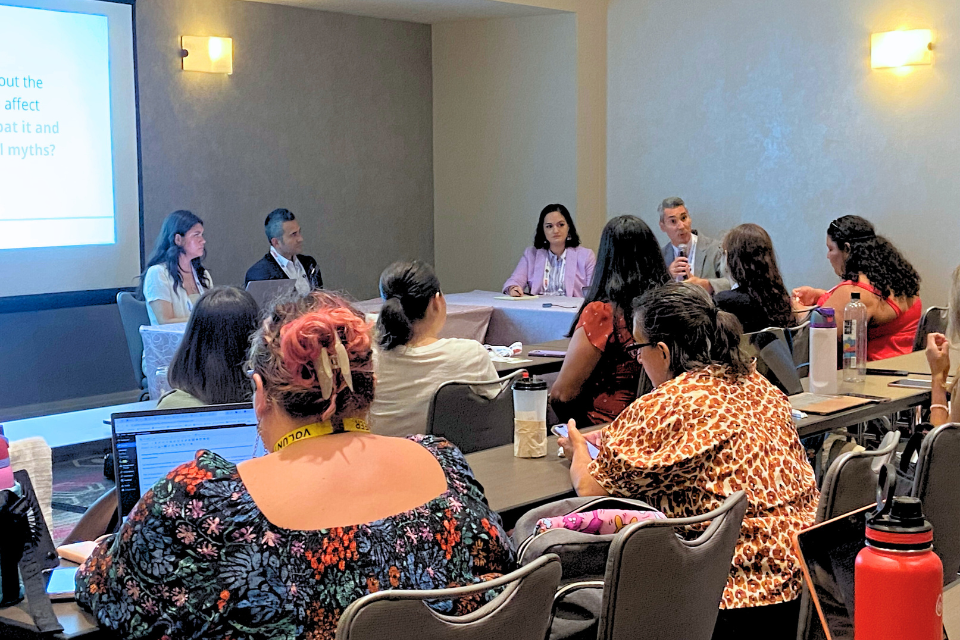By Cara Kenefick
CTLatinoNews.com
Domestic violence will not be tolerated, and Sgt. Glendaly Garcia wants all of Hartford to know it.
Garcia, of the Hartford Police Department’s Internal Affairs division, has taken the lead to get victims of domestic violence the services they need and to hold perpetrators of the crime accountable.
This summer, a newly-established team and program will be rolled out to crack down on the domestic violence rate in Hartford.
Answering the call
Garcia is Hartford, through and through. She was born and raised in the city, attended Hartford Public Schools and went on to graduate from the University of Hartford.
“I grew up with a very small, close-knit family that taught Latin morals and responsibility,” she said.
Growing up in Hartford, Garcia was exposed to things no child should have to see, but many do. Most notably, she recalled losing several of her classmates to gun violence. Her early experiences with the realities of urban violence made it “a little difficult to cope”, she admitted.
“Based on my family upbringing, that was not something I wanted to get involved with, that’s for certain,” she said. “I felt that my experiences growing up really didn’t identify who I represent.”
Despite the prevalence of violence in her childhood, Garcia said communication and language barriers were constant in her community when dealing with police.
“It’s not to say that [police] didn’t care, but because of cultural barriers linguistically, people walked away with the ‘nothing is going to be done’ mentality,” she explained. That roadblock her friends and family faced ended up inspiring her to quit her job as an EMT and take the test to become a Hartford police officer.
Surprising herself, she passed the series of tests and began training at the police academy a short time later.
Last November, after several years of moving up through the ranks and leaving her mark in many different departments, Garcia transferred to the Internal Affairs division. Although her background was in investigation (she was formerly a detective), she now has one main goal: creating a no-tolerance attitude towards domestic violence in Hartford.
Fixing a broken system
Every week, Garcia seeks 90 to 100 domestic violence cases cross her desk. In a perfect world, she said, that number would be zero. Until that day, her division continues to track the most serious cases and file repeat offenders.
Oftentimes, the victim does not have the education or knowledge to protect themselves against domestic violence or get the services they need after it occurs. The problem, she said, is that there is no one helping them at the legal level. Again, problems communicating is a frequent roadblock.
“There’s a language barrier and it affects the outcome of the case,” she said. “They walk out, they go home together. It’s a cycle.”
That cycle is the flaw in the system Garcia is working so diligently to correct, and breaking it is one of the keys to reducing incidence of domestic violence.
Dual arrests, where both the man and woman are arrested during a domestic violence situation, are also problematic, Garcia said, especially when children are involved. If a woman is arrested for hitting her husband in self-defense, the woman is then not able to receive the services and resources available to victims suffering from domestic violence, she explained.
She said consistent training with officers to assess each situation and the ability to be empathetic toward victims in situations of domestic violence is the best solution to the dual arrest issue.
Teaming up against domestic violence
The Hartford Police Department is taking a two-pronged approach to curbing domestic violence in Hartford: First, by collaborating with organizations to target potentially high-risk cases, and second, by creating a Domestic Violence Team to track their results.
Garcia and her team have developed a partnership with Interval House, Connecticut’s largest non-profit agency for women, which works closely with the Connecticut Coalition Against Domestic Violence (CCADV).
The police department and the two agencies will work together to implement the Lethality Assessment Program, which identifies high-risk cases. The model has already shown success in some Maryland communities, Garcia said.
The assessment asks victims a series of questions, such as how long have they known the aggressor, if they have children, whether the aggressor has a firearm, if have they ever been strangled, and if the aggressor is controlling.
Potentially high-risk cases are then identified by the scores of the assessment. Those cases can then be closely monitored and services will be rendered to them.
The program was originally implemented in Oct. 2012 across 14 Connecticut police departments.
According to Joe Froehlich, Law Enforcement Coordinator at CCADV, 60 percent of the 763 screenings completed so far were found to be “high danger.” Of the 458 high danger cases, 88 percent of the victims ended up speaking with a hotline worker and 66 percent received services.
One of those services is having an advocate accompany victims to court. “If he’s there intimidating her, [the victim] is not walking into court alone. There’s an advocate there with her,” Garcia said.
Even though officers are mandated by the state to follow up with every report, Garcia said there are just not enough resources for that to always happen. She hopes the new system and access to resources will help victims get the attention and support they need.
“If it means placing a higher bond to buy more time to put women in a shelter or be protected, that’s what we’ll do.”
The program is expected to be in place by July.
About the creation of the Domestic Violence Team, Garcia said she is “elated.” The team has already begun to meet monthly with the State Attorney’s Office, the Department of Children and Families, and victim advocates.
The team will monitor high-risk cases, provide services, and statistically track the mother, father and children. Over a three to four-year process, the team will identify those cases, ensure they continue to receive the services they need and monitor the conviction rate.
Ultimately, the programs will identify the domestic violence cases that are the highest-risk and allow the police department to swiftly act on them so the victims are helped and the suspects are held accountable, Garcia said.
Domestic violence is a “nuclear” situation
Even though Garcia is no longer on patrol, she remembers what it was like as an officer to go into volatile domestic situations. For her, walking into a domestic dispute was “scary” and “intimidating.” The fear of the the unknown, like hidden weapons or flaring tempers, made her situation even more tense.
“I’m basically a complete stranger walking into someone’s house to be a mediator,” she said. “You’re walking into an unfamiliar scene, you don’t know if they’re going to snap.”
What many people don’t realize, she said, is that basically all domestic situations have the potential to be lethal or high risk in one way or another. In the heat of the moment, people do unexpected, and at times, unexplainable things.
“It’s nuclear, there’s no question.”
Changing Hartford’s mentality
The ultimate message Garcia wants to send to Hartford is that domestic violence is no longer an option in her city.
“Theoretically, the domestic violence rate in Hartford is so high and there’s so little accountability, they get comfortable,” she said.
If word gets out that violent, repeat-offenders are finally being arrested and sentenced, the impact will be “huge.”
“We want people to think, ‘I can’t commit domestic violence in Hartford.’”



